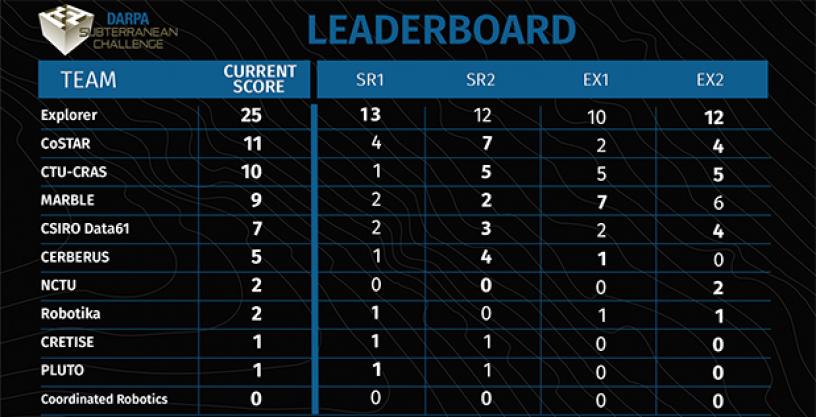Explorer posted the highest overall score; CTU-CRAS earned the highest score among self-funded teams and the $200K prize

Aug 22, 2019
Subterranean (SubT) Challenge Systems teams are trekking toward the Urban Circuit after competing in the Tunnel Circuit, the first scored event of DARPA’s high-tech underground contest. Eleven teams from eight countries gathered in Pittsburgh, August 15-22, 2019, to attempt to map, identify, and report artifacts along the passages of two Pittsburgh mines. With them, they brought 20 unmanned aerial vehicles, 64 ground robots, and one autonomous blimp robot named Duckiefloat.
DARPA-funded and self-funded teams compete side-by-side throughout the Subterranean Challenge. Only self-funded teams are eligible for prizes in the Circuit Events, but they must finish in the top five overall. All qualified teams are eligible for prizes in the Final Event.
Teams in the Tunnel Circuit completed four total runs, two 60-minute runs on each of two courses, Experimental and Safety Research. The courses varied in difficulty and included 20 artifacts each. Teams earned points by correctly identifying artifacts within a five-meter accuracy. The final score was a total of each team’s best score from each of the courses. In instances of a points tie, team rank was determined by (1) earliest time the last artifact was successfully reported, averaged across the team’s best runs on each course; (2) earliest time the first artifact was successfully reported, averaged across the team’s best runs on each course; and (3) lowest average time across all valid artifact reports, averaged across the team’s best runs on each course.
The final scores were as follows:
- 25: Explorer, DARPA-funded
- 11: CoSTAR (Collaborative SubTerranean Autonomous Resilient Robots), DARPA-funded
- 10: CTU-CRAS, self-funded winner of the $200,000 Tunnel Circuit prize
- 9: MARBLE (Multi-agent Autonomy with Radar-Based Localization for Exploration), DARPA-funded
- 7: CSIRO Data61, DARPA-funded
- 5: CERBERUS (CollaborativE walking & flying RoBots for autonomous ExploRation in Underground Settings), DARPA-funded
- 2: NCTU (National Chiao Tung University), self-funded
- 2: Robotika, self-funded
- 1: CRETISE (Collaborative Robot Exploration and Teaming In Subterranean Environments), DARPA-funded
- 1: PLUTO (Pennsylvania Laboratory for Underground Tunnel Operations), DARPA-funded
- 0: Coordinated Robotics, self-funded
The first of three circuits, the Tunnel Circuit represents a human-made tunnel, including those used for mining operations.
“We designed the Subterranean Challenge motivated primarily by warfighter needs, as well as those of the first responder communities. We are inspired by the need to conduct search and rescue missions in a variety of underground environments, whether in response to an incident in a highly populated area, a natural disaster, or for mine rescue,” said Timothy Chung, program manager for the SubT Challenge in DARPA’s Tactical Technology Office.
“Teams gathered valuable data at the Tunnel Circuit to help them improve systems and sensors for the Urban and Cave Circuits, but they should also prepare for a few new surprises. The SubT Challenge could be compared to a triathlon. DARPA is not looking just for the strongest swimmer, runner, or cyclist, but rather integrated solutions that can do all three.”
Researchers, engineers, roboticists, and robot enthusiasts inspired by the Tunnel Circuit still have time to apply to compete in the Urban Circuit, which will take place in February 2020. The qualification deadline is in October. Requirements can be found in the SubT Challenge Qualification Guide available on the Resources Page.
Teams also may submit for qualification in the complementary Virtual Competition in which teams develop software-based approaches to test on a simulated course. Interested teams are encouraged to join the SubT Community Forum, where they can engage with other participants and ask questions.
The Cave Circuit will take place in August 2020. The Final Event incorporating all three subdomains will be in August 2021.
Teams in the Systems Competition will compete for up to $2 million in the Systems Final Event, with up to $200,000 in additional prizes available for self-funded teams in each of the Systems Circuit events. Teams in the Virtual Competition will compete for up to $1.5 million in the Virtual Final Event, with additional prizes of up to $500,000 for self-funded teams in each of the Virtual Circuit Events.
For additional information on the DARPA Subterranean Challenge, please visit www.subtchallenge.com. Email questions to SubTChallenge@darpa.mil.
Image Caption: Final leaderboard from Subterranean Challenge Tunnel Circuit
# # #
Media with inquiries should contact DARPA Public Affairs at outreach@darpa.mil
Associated images posted on www.darpa.mil and video posted at www.youtube.com/darpatv may be reused according to the terms of the DARPA User Agreement, available here: http://go.usa.gov/cuTXR.
Tweet @darpa
